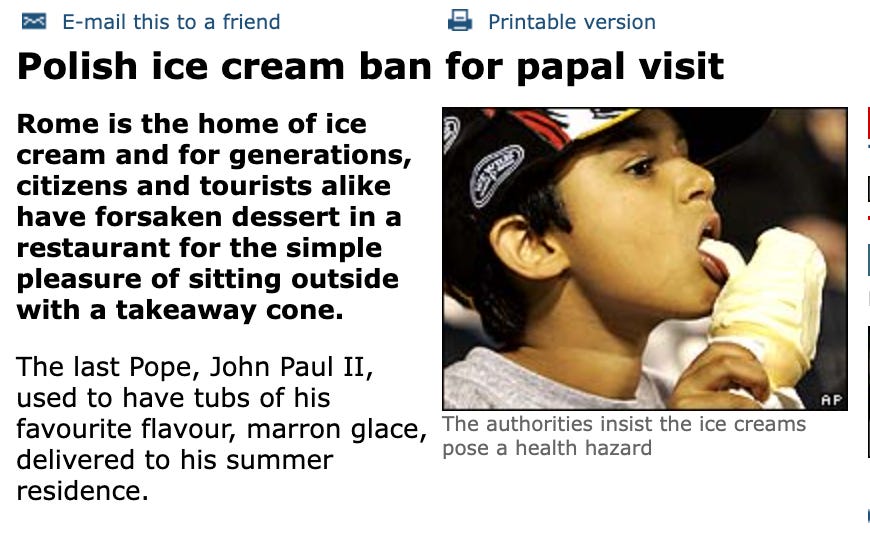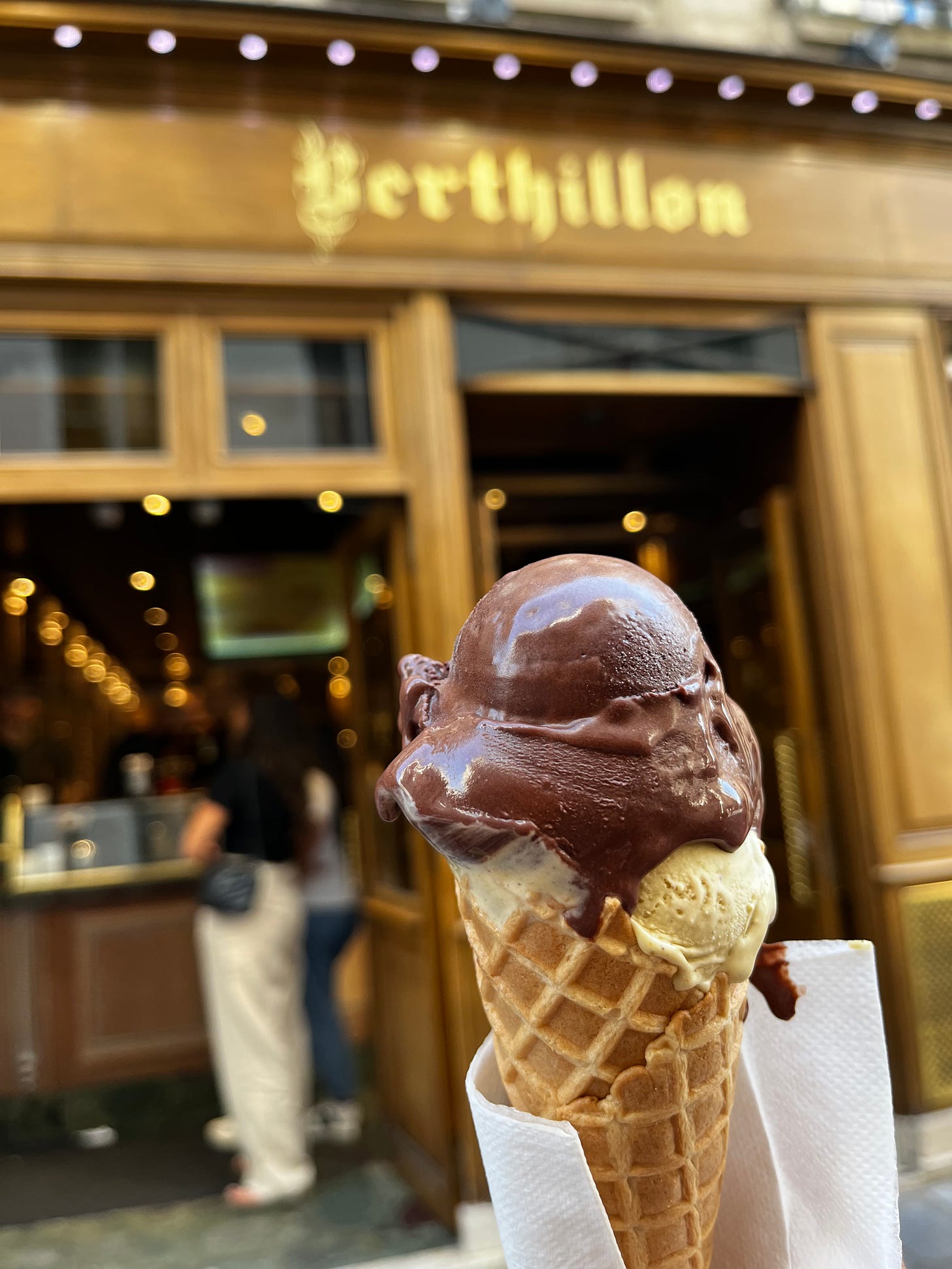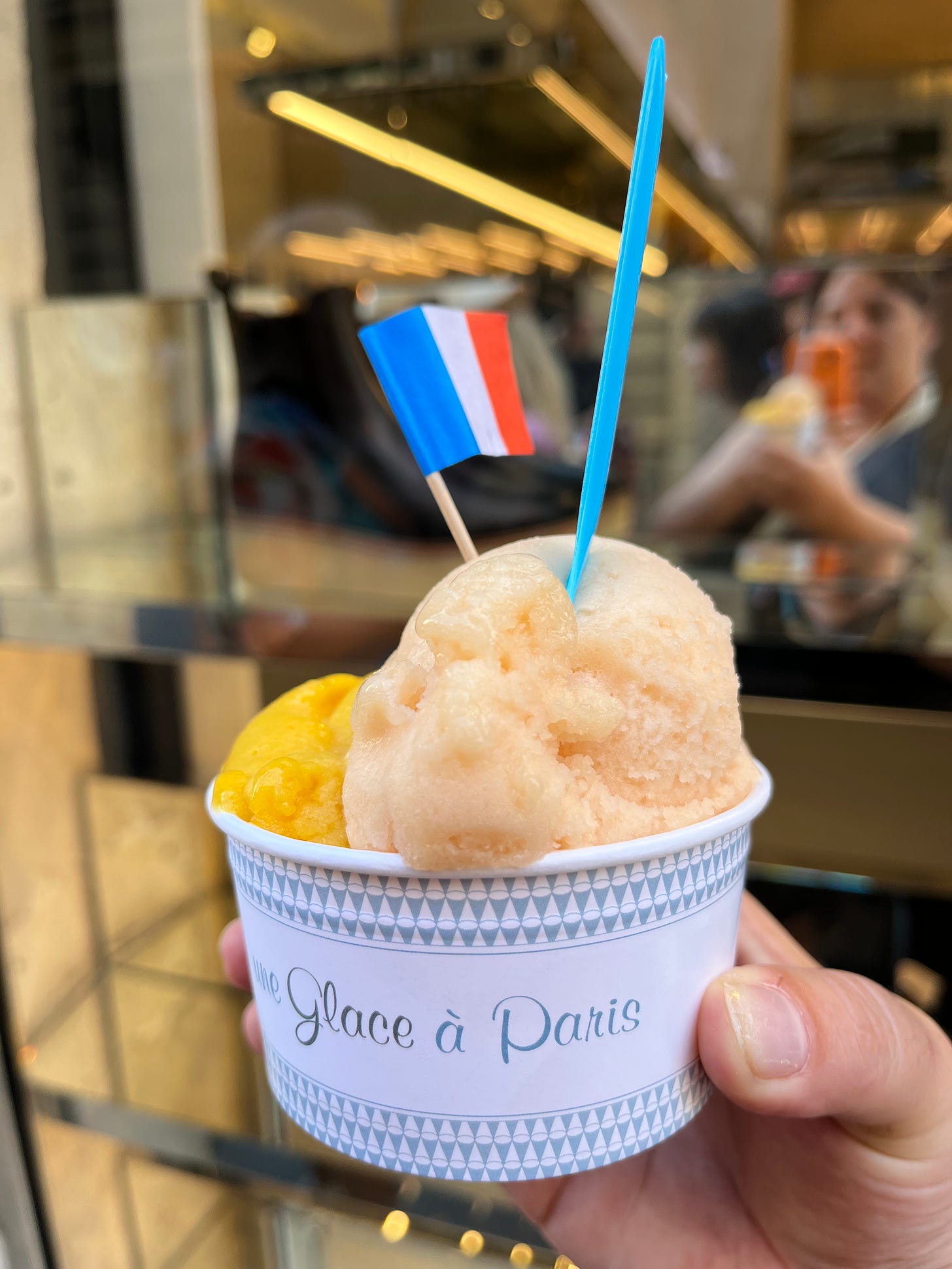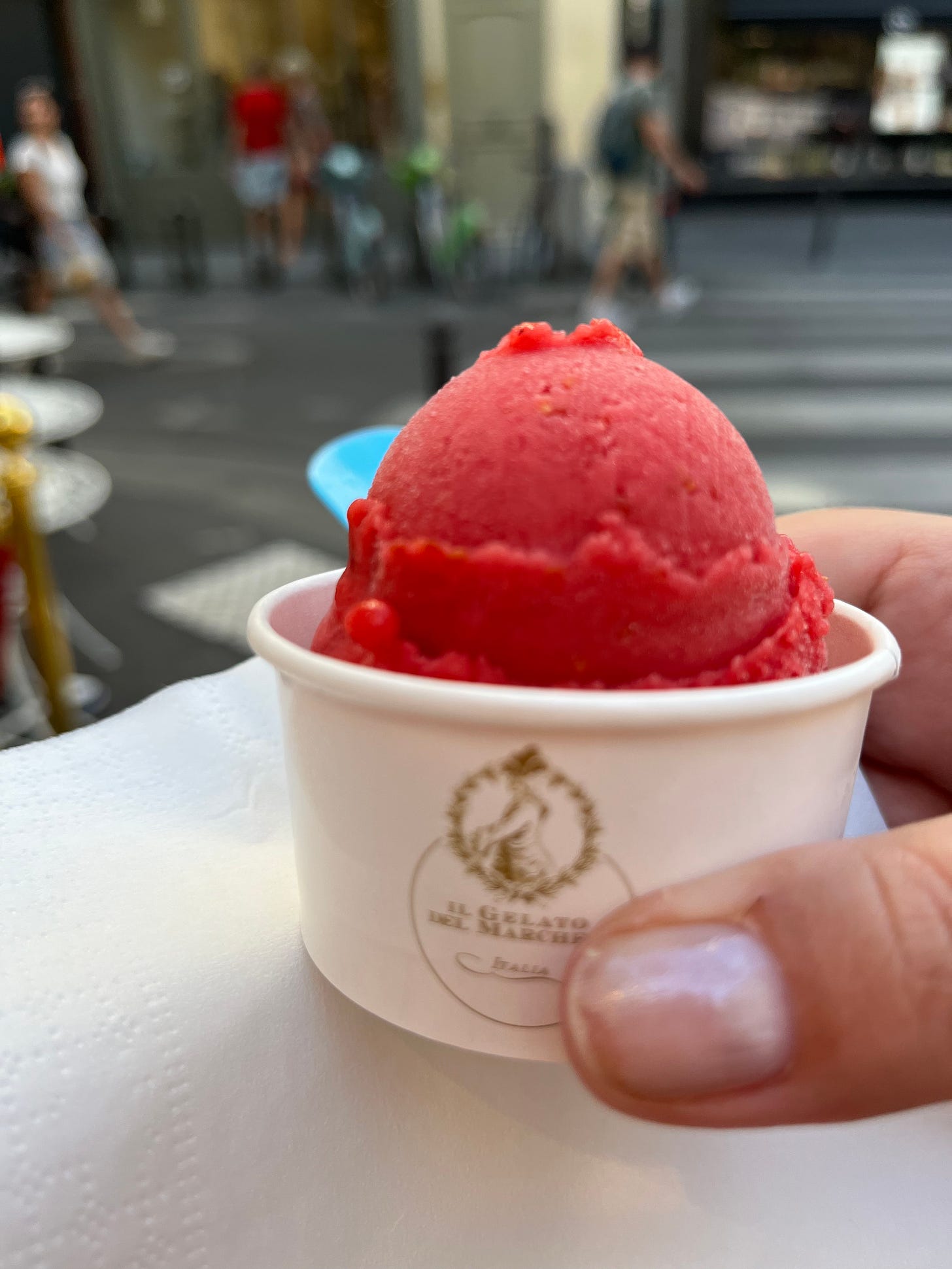Everything I Know About Ice Cream
People have a lot of feelings about ice cream and what it means if they eat it. Plus, where I've eaten ice cream in Paris <3
I want to talk to you about ice cream, about what it is and what is not, and what it can offer us, both as people with bodies that experience pleasure and as people who care about how stories are told. Partly I want to do this because I am in Paris for the month of September and this city is currently experiencing a heatwave the likes of which has never been seen before at this time of year! Huzzah, lucky me and Joyfriend! I respect the hell out of the French for not believing in air conditioning but I am a highly hot and sweaty person.
Friends and lovers and people on the internet know me now as the Full Fat Ice Cream Lady and both send and solicit hot tips for particularly delicious high-butterfat ice cream the world over. I embrace this honorific. I used to have a public Google map of my ice cream travels and a lowly Instagram account devoted to reviewing ice cream on a scale of one to ten moos. I have driven a hundred miles and walked through cow pies for a particularly biting espresso chip or a brilliantly balanced blackberry.
But perhaps, with my enthusiasm for quality and flavor, I’ve given you the wrong idea: for me these days, ice cream is not a quest or destination, not a special occasion, not a “treat” or a “splurge” or an “indulgence” or a “temptation”; not something “decadent” or “sinful” — all words that I hear applied to ice cream all the time. Ice cream is just a food that is in my weekly rotation and that I add to my grocery list like any other food. But the problem is, that it’s also: not.
People have a lot of feelings about ice cream and what it means if they eat it. Ice cream is emotional, social, cultural. In movies, it’s ice cream the sad woman is eating when her heart is broken and it’s ice cream the sexy woman is eating on the first date with the lover that will shape her life. I find that people are often looking for permission to eat ice cream, and once I give it to them by eating it myself, interesting things happen. At first my friend cuts the chunks with the side of her spoon, but soon she is shoveling great heaps into her mouth. Another friend’s father does the opposite—for all other foods he is a shoveler, but he eats ice cream in little bites with his bottom teeth. A past lover claimed he did not like chocolate and was generally uninterested in sweets but when he tasted my mocha chip, he came over to share my side of the bench, wrapping me in both of his arms and sighing, the quietest sigh you ever heard.
Ice cream “lights up the same pleasure centre in the brain as winning money or listening to your favorite music.” Its unique combination of the proteins in dairy (tryptophan mostly) and a great quantity of fat all at once boosts neurotransmitters that raise dopamine levels and increase serotonin production, making us feel calm and soothed. In one study, volunteers were administered fatty, sweet, or salty solutions and then shown sad pictures and played sad music; when they got the fatty solution, the intensity of their sad emotions was reduced by almost half.
"Many of us have what's called a 'bliss point' – the point at which we get the greatest pleasure from sugar, fat or salt,” Professor David Kessler told The Telegraph (though I object to Kessler’s characterization of ice cream as a “junk food.) According the Kessler, this bliss is the result of an exact combination of tastes that triggers neurons in our brains. Foods like pizza, tomato sauces, salad dressings, and Dr. Pepper, are analyzed by corporate brands and then “optimized” in an effort to hit this bliss point. But good ice cream requires no optimization. It is already optimal.
Fundamentally, ice cream is pleasure to me and much is revealed about how a person thinks about pleasure via the way they talk about ice cream. But here is what I am trying to tell you: I was not always this way, and neither was ice cream.
In the apartment where I grew up we had an ancient SubZero with a bottom freezer drawer that was the sole domain of my father. He was in a perpetual war with the ice machine: he wanted the ice machine to make ice; the ice machine didn’t. He kept coffee beans in there; lentil soup, vegetable stock in freezer-burned beige Tupperwares, and sesame bagels from Fairway. Also popsicles—lime, lemon, Weight Watchers Fudgsicles, Atkins diet creamsicles; bags of ice colored and flavored to look and taste like the real thing: ice cream. Of course it wasn’t that my father had never tried ice cream, it was that he had tried it and liked it too much. Ice cream was dangerous, eschewed, forbidden.
My father feared dairy, specifically cream. He didn’t drink milk at all, not even the skim my mother bought for my sister and me. Cream cheese, brie, butter; these were white and globby, and thus like cyanide to him. If he ordered soup in a restaurant he always double checked—is there cream in that? In his imagination, I think, dairy was for gentiles, for the suburban and the Midwestern, for buxom farm maidens on their tiny wooden stools, while cows loled in the soft, flabby background. My dad wanted to be hard, to be fast, to matter. He walked in the gutter through the streets of Time Square, lapping the tourists. He drank martinis—very dry, in and out on the vermouth, three olives for luck.
Actually, my father retained absolute control not only over the bottom drawer of the SubZero, but over the whole appliance. Every night he organized and re-organized the fridge, stacking like with like. Whenever he heard the whooshing sound of the refrigerator door opening he would appear in the kitchen to inquire what the intruder was eating and why. If you walked by with an apple, he had to touch it and make a comment about its shape or size. If he bought bread for dinner, death be to she who took a slice for lunch. If he bought clementines and they weren’t eaten within a week, they were declared to be not “moving,” and were never bought again. If my mother bought the special tuna fish from Jefferson Market—full of mayonnaise and some magical combination of spices I have never managed to replicate—my father would divide it between two plastic containers and add flavorless canned tuna to each half, cutting it with dryness. (To be fair, here may have been where pleasure-denying and thriftiness overlapped; my father’s mother had been a balabusta—Yiddish for a woman with the gift for stretching a dollar.) So open were these habits and the rest of our family’s resentment of them, yet also our complicity in them, that we made him a black hat with yellow embroidered letters across the front that said FOOD POLICE. This hat haunts me: that I accepted, even tried to laugh at, the state of food surveillance I was raised in.
I discovered strawberry ice cream in the house of a childhood friend when both she and her family were away. Away where? And why was I there alone? The only thing that sticks around is sitting on their black leather sectional and eating from their tub of ice cream with its chunks of whole strawberry while watching Jerry Springer (tawdry, transphobic).
I sometimes cat sat for the couple that lived in the apartment a few floors above my family just so I could eat their mint chip ice cream—a sharp journey into the Swiss Alps, a crystal clean feeling all over. Their cat, Sam, was a lumbering orange purr machine who was supposed to have died the previous winter from diabetes but instead had made a miraculous recovery during a visit to Palm Springs. He observed me as I ate the ice cream straight from the container—not enough that it would be missed, I hoped.
These experiences, organized by ice cream, were some of the few places I could be alone for vast swaths of time, as our apartment was essentially a single open space with a few pieces of sheetrock posing as walls. My sister was properly fat at a young age, and I was getting there. Our apartment rattled with endless reasons fatness was wrong—your health, your future, your love, your mind—and a fate worse than death. Then my sister went away to college and with her gone, there was only my body for my father to worry about and look at. If I went to the fridge to retrieve a snack my father offered his opinion as to where on my body it would end up. He watched me, vigilant for signs of fatness, which increased. Ice cream would occasionally materialize in the freezer, but if I didn’t pounce upon it right away it would disappear just as magically as it had appeared, the only record of its presence the empty carton stuffed down deeply into the side of the trash can. I took to buying pints myself and transporting them straight from the deli into my room, bypassing the kitchen entirely.
In its beginning, ice cream was not so much an act of pleasure as an act of enormous labor, a fight against distance and temperature and weather, a logistical near impossibility. In the first century AD, Roman emperor Nero Claudius Caesar sent runners miles into the mountains for snow that would then be flavored with fruit nectar. The ancient Persians constructed expensive ice houses to store winter snow year round to be served with grape juice. The cream entered later when the first King of the Chinese Shang dynasty employed more than 90 men to make frozen buffalo milk, thickened with flour and flavored with camphor. (“You’re welcome,” my Chinese-Viet-American Joyfriend calls from across the room as I write this).
In its early days in America, ice cream was possible only for the very rich, but when insulated ice houses and commercial dairy production made it widely available, its character shifted from signifying wealth to signifying moral weakness. Churches and ministers at the turn of the 19th century observed ice cream’s ecstatic effect on their parishioners and declared eating ice cream a sin. In 1890 in Evanston, Illinois, the local Methodist church lobbied successfully to ban ice cream sodas on Sundays. When Pope John Paul II visited his birth place in Poland in 2006, the town banned ice cream for the duration of his stay as a kind of religious offering—this despite the fact that his holiness regularly had tubs of his favorite marron glacé ice cream delivered to his summer home.
In the 1976 document “Dietary Goals for the People of the United States,” Senator George McGovern asserted that a low-fat diet was essential not just for patients with a high risk of heart disease but for us all. “Out were cream, chocolate, cheese,” writes Ann LaBerge in “How the Ideology of Low Fat Conquered America.” “What could be eaten? Fruit, but no cream. Low-fat advocates preferred processed substitutes, such as Cool-Whip.” So pervasive was this low-fat propaganda through the 1980s and 1990s that many began to think of fat, particularly dairy fat, not just in scientific terms but in emotional and moral ones—as dangerous, repulsive, and wrong.
“Butter is back,” declared Mark Bittman in a 2014 New York Times opinion piece. “Let’s not think about the literally millions of people who are repelled by fat, not because it doesn’t taste good (any chef will tell you that “fat is flavor”) but because they have been brainwashed.”
My father never wore the FOOD POLICE hat; he put it in a kitchen drawer with the batteries and the Chinese take out menus. Aging has been a rock tumbler for my parents, grinding away their sharpest points. For years my father has supported the growth of my mind and my career as a writer by sending me newspaper clippings about things he thinks I will find interesting. The note always reads, FYI, love Dad. Acknowledging my interest in ice cream, and as a gesture of love, he now sends me articles about new ice cream openings and pictures of cream churning. Though he cannot access pleasure, he wants me to, I think.
Away and out in the world, I’ve forged my own relationship with ice cream. Now that I have my own freezer, I usually have at least three flavors of ice cream in my freezer at any given moment. I might go weeks without eating it, but I like to know it’s there. Cones can be fun and glass dishes are pretty but my preferred ice cream experience will always be straight from the carton; I like the flat surface and how it changes as I eat it—the creamy depressions mapping where I have been. I’ve begun to use this as a kind of friendship litmus test. If we can sit and eat a pint of ice cream together, we can be the best of friends. If you have to comment about how “bad” you are being by eating it, we probably cannot.
One thing I have learned in re-telling the story of ice cream is that there is no rush, there is no urgency, there is no one who will eat the ice cream out from under me or throw it away if I don’t finish it myself. I can have a little or a lot and put the carton back and it will still be there the next day. There is enough for everyone and if there isn’t, I can always buy more. Going on an ice cream expedition to a new ice cream place is just fun and delicious for me now, not necessarily an act of familial or political rebellion. If ice cream and I were fictional characters, I would say we began as Romeo and Juliet then became Tina-and-Bette-style codependent lesbians, and are now more like Blanche, Rose, Dorothy, and Sofia of The Golden Girls in which I am Blanche and the others are perhaps hard ice cream, soft serve/frozen custard, and gelato.
What I am trying to tell you: this is what it looks like when you put all your fear and longing into one single container. How we think about foods and what they mean change. Ice cream hasn’t always meant gluttony. And it doesn’t have to, again.
And as a final lick, here’s where I recommend eating ice cream in Paris.
Berthillon is the classic that has sort of subsumed the whole Ilê Saint-Louis. Make sure you go to the actual store at 31 rue saint louis en l'ile instead of one of the many places that just buys and serves their product. I got the chocolate and pistachio, people flip for the praline and the passionfruit too.
Une Glace à Paris has never done me wrong and since 2020 has a second location in the 18th. We went to their flagship in the Marais and were impressed yet again by their texture and the intensity of their flavors. Because of the heat, I got passionfruit and grapefruit. Joyfriend got hazelnut and pistachio orange blossom. They gave us little french flags because I ordered in French and they were like, “you tried.”
Across the street from Une Glace in the Marais is Pierre Hermé, which is more known for their macarons but which actually has excellent ice cream as well, in takeaway containers. I have it on good authority that they also do macaron ice cream sandwiches!
We also hit Il Gelato del Marchese in St. Germain for a fruity, cold reprieve from the scorching heat. Pictured here is the raspberry; Joyfriend got lemon mint and both were exceptional.
Finally, we’re headed off today to Folderol. My friend, the James Beard award nominated food writer Catherine Down says, “Folderol is not to be missed! It’s a wine shop and ice cream shop with really exciting, interesting flavors. It’s run by the fantastic team formerly behind Le Rigmarole. Note: they’re only open late afternoons into the evenings.” Catherine also recommends Raimo in the 12th.
That’s all I know about ice cream. I hope you can join me in this Golden Retirement Home of frozen treats. It would be my pleasure.
yours,
Emma
Portions of this essay originally appeared in Tin House magazine under the title, “The Bliss Point.”














Love this, thanks for writing it and writing it so well. Great mix of personal & reporting.
Related to butter being back, when are Starbucks & similar going to stop thinking vegetarians don't want yolks?
So much flavor and depth here - intelligently examined from all sides! It’s stunning how much food policing goes on and how tangled up people feel when food is blissfully good. One thing that always stuck with me was the idea (from child psychologist and researcher Leann Birch) that parents should let children decide when they’re satisfied, to give them that autonomy as a birthright.